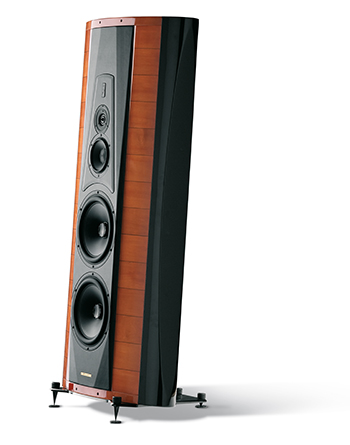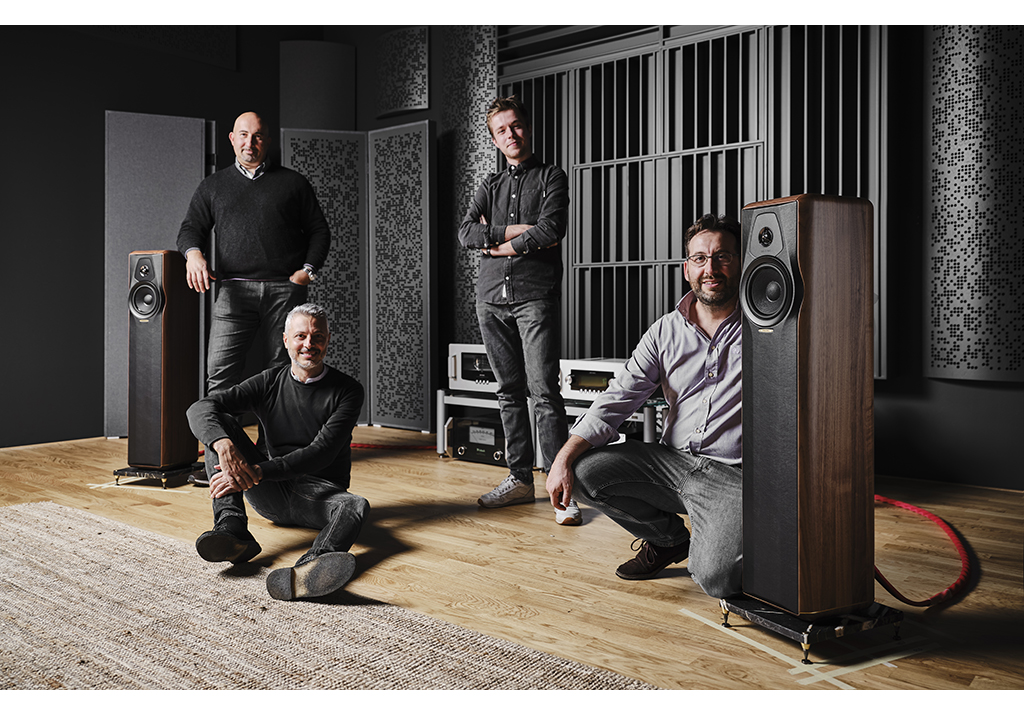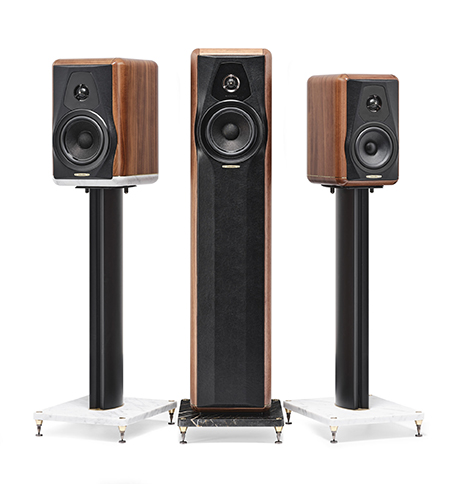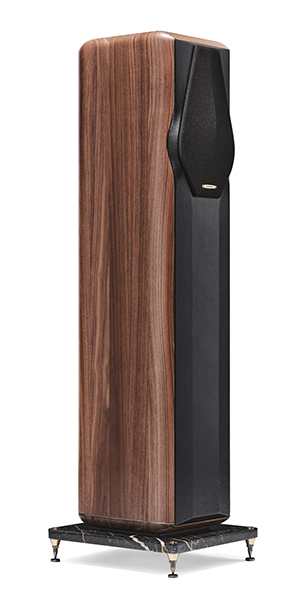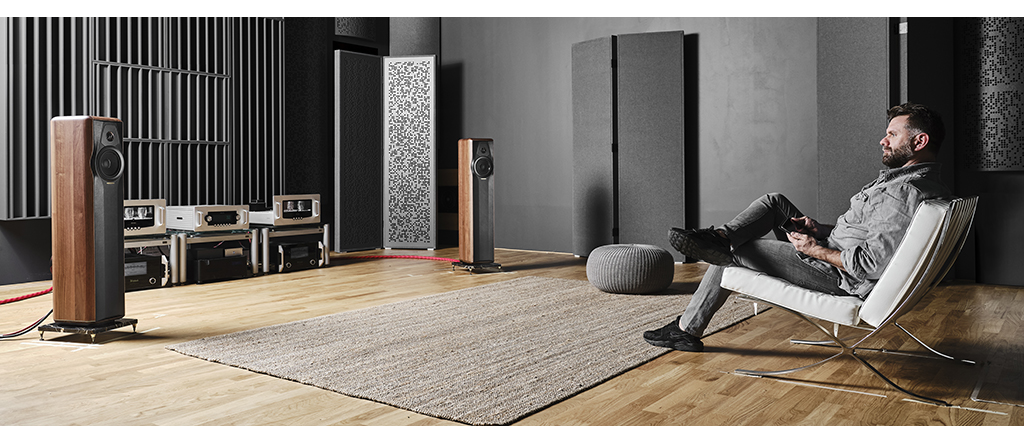The Sonus faber Maxima Amator Love at First Listen
By Jeff DorgayI’m somewhat of a Sonus faber fanboy for those of you who don’t know, but it’s complicated. My reference speakers are Stradivaris. Old School.
I’m not quite as bad as the old guy at the cars and coffee get-together claiming that the last real Porsche was the 356, but I’m particular about what I like. I try my best not to let that get in the way, trying to help you on your quest to find what you like, but it’s important you know my preferences before we begin.
Like most premium audio brands, Sonus faber’s legacy products have a particular sound. Current products tend to be more refined, reflecting advances made at the component level over the last 10 to 20 years. Capacitors, resistors, wire, and such have all gotten better. This translates to a higher degree of transparency, image focus, and dynamics. More seat time in the engineering chair reveals more music too.
The Stradivaris that I use as a reference are the final iteration of founder Franco Serblin’s vision. The current Aida, Lillium, and Cremonese speakers all have been designed under Sonus faber’s current team, headed by Brand Ambassador Paolo Tezzon and Chief Design officer, Livio Cucuzza, representing the current direction. This team has done a fantastic job at incorporating the emotional involvement that has made SF famous while adding more extension and transparency to the mix. A slightly more “modern” Sonus faber, if you will.
This leads us to the Sonus faber Maxima Amator
If you’re new to the game with Sonus faber, their speakers are big, bold, and dynamic, with a fashion-forward sense of design. The woofers mounted to the leather-covered baffles have SF logos on the caps, with bright chrome rings surrounding the drivers. You know this is a Sonus faber, the second you remove the grilles, even if you don’t know the first thing about audio.
Taking the aesthetic/beauty thing a little further, every friend that has ever stopped by to listen to the Strads or any other Sonus faber speaker we’ve had in for review and not say, “I need a pair of those in my living room.” Or their partner always says, “now that’s a pair of speakers I’d go for in the living room.” And that’s usually before they even hear them. That’s love.
The Maxima Amator harkens back to the beginning of Sonus faber, perhaps to the end of their founder, Franco Serblin’s tenure at the company. These compact floor-standing speakers have a more understated look, requiring only a small amount of listening space to perform. And perform they do.
Many question the concept of love at first sight, or perhaps in our case, love at first listen, first encounter. However, if you know what you are looking for, it’s not so odd after all. Speakers can be the most challenging part of the equation when putting a system together because other than phono cartridges, they have the widest variation of sound. Electronics have a voice, to be sure, and indeed some designers take great effort to try and make their amplifiers, preamplifiers, and DACs to have as little coloration as possible. Still, the variation on the theme is nothing like it is with speakers. Keep in mind that nothing interacts with your listening environment as much as speakers do either. Choices.
Witness all the variations on the theme that we see in speaker design: big, small, horns, panels, 2-ways, 5-ways, 6db/octave crossovers, 45db/octave crossovers, digital crossovers, and none at all. Speakers are like paintings – the artist’s (or, in this case, the designer/design team’s) vision of what sound should be. Of course, measurements play into this game somewhat, but in the end, most speakers convey the vision of what their designer feels music sounds like to them. Do you want Norman Rockwell, Picasso, Andy Warhol, or Cezanne?
Which is the right choice? The choice that aligns perfectly with how you feel music sounds to you. Designing speakers is a rough business because, in addition to all the aforementioned variables, many people have never heard live music. Think about that for a minute. Ask your friends that are outside the circle of your audio enthusiast friends how many live performances they’ve seen in their lifetime. Increase the level of difficulty and narrow the search parameters. How many have listened to a symphony orchestra, a string quartet, or even a person on the street corner playing an acoustic guitar in the open air?
Even with electronic instruments, what does a Fender Stratocaster really sound like? Not much if it isn’t plugged in. Once that happens, witness the variations that every great guitarist brings to the table – if you love listening to guitarists, you probably enjoy them all. The same for pianists – yet one pianist prefers a Steinway, another Yamaha, while still another swears they can only make music on a Bosendorfer. Which is the right choice?
This is why we don’t make empty promises about one speaker or another being “the best” of anything. It all goes back to you being able to define what provides the most engaging experience for you. On one level, it gets more difficult if you actually play an instrument. Now you have a point of reference. But that’s what makes it fun.
Instant gratification
Fortunately, the review samples we were sent already had hours on the clock, so an extensive break-in period was unnecessary. Our past experience with breaking in other Sonus faber speakers is always about 100-200 hours to deliver their full performance, but we’ve never heard a Sonus faber speaker sound bad, fresh out of the box. However, driver surrounds require a bit of mechanical break-in, and the capacitors in the crossover network also take some time with signals passing through them to sound their best.
What you’ll notice, opening a new pair of Maximas, is the slightest bit of muddiness in the upper bass, yet at the same time, the speakers will not go quite as deep without effort. This will require a slight adjustment in positioning after a couple of weeks because they will have more LF extension than they did when unboxed. It’s also worth your while to have a hex wrench handy to make sure the woofer hasn’t loosened up a bit in its mounting. We’ve seen more than one speaker become more diffuse and less defined, only to find, the woofers are not snugged down anymore.
Listening
Getting right at the Maxima Amator’s capabilities requires well-worn demo tracks. Somehow, we always fire up “Bug Powder Dust (dub)” from The K&D Sessions when a new speaker arrives. Tight, controlled bass, convincing me that these speakers in a medium-sized room will easily hit the 35hz low-frequency spec Sonus faber claims.
But we can’t live on bass alone. This record is full of sonic tidbits that fly around the room on a great set of speakers, and these are great speakers. In the context of our 13 x 18-foot room, the Maxima Amators create a massive ball of sound – no need for surround speakers. This is what high-performance two-channel audio is all about. Even out in our main listening room, (16 x 24 feet) these speakers fill it easily. However, they are dwarfed somewhat by the Strads.
Listening for the bongos in Timewarp Inc’s “Groovy Booty” is equally exciting. This track has such a strong bass line that the bongos often get buried. Through the Maximas, they have a space and a life of their own. The ability of these speakers to find the groove in any track is unbelievably good.
The Minima in the Amator line shares a tweeter with the Olympica Nova collection, while the Electa and Maxima a tweeter with the Homage Tradition and Reference collections. The Electa and Maxima share the same woofer (a 6-inch drive unit, where the Minima has a 5-inch drive unit), so they all speak with a similar voice. Looking at the specs, the Minima goes to 50hz, the Electa to 40hz, and the Maxima to 35hz. Judging this trio of speakers by specs alone, the casual observer might think, “no big deal.” But the magic that the Maxima brings transcends the spec sheet.
Along with their enticing tonality, these speakers all share a wide dispersion characteristic, making them easy to place. This also offers an engaging experience to all in the room. Good as the Maximas sound in the sweet spot from your couch or listening chair, they sound great off-axis too. Party guests sitting on the floor or the other side of the room will still enjoy a major musical experience.
Where early SF speakers have a touch of warmth that can’t be dialed out, sacrificing resolution and extension, in the process, the Maxima Amator is unmistakably SF, but no sacrifices are made. If you happen to be a huge fan of vintage SF sound, you will not be disappointed, yet there is a delicacy to the high frequencies and additional spatial cues that your old speakers just can’t manage. The blend of new and old school is fantastic. Even the Sonus faber people admit on their social media channels that this one has a certain magic to it. Not everything can be summed up with test equipment. Sometimes God truly is in the details.
No disrespect to the greatness that has come before, but the Maxima is a credit to the current design team. Perhaps it’s just that these speakers are the two-way monitor concept taken to its ultimate end. The stand mount Amator is close, but it doesn’t have quite the cohesiveness and lacks lower bass extension due to a smaller cabinet volume. Considering the cost of factoring good stands in, go for the floorstanders. I know I’m disobeying the prime directive here. However, I love the visual continuity of a small floorstanding speaker instead of a monitor on a stand.
Going back to some vintage R&B, tracking through the Fifth Dimension’s “One Less Bell to Answer” again reveals the Minimas ability to unpack dense recordings, giving all the vocalists their own sonic space. As with similar tracks that felt previously difficult to listen to, the Sonus fabers breathe live into recordings in a way that few speakers can. Are they the last word in ultimate resolution? No, but there is more than enough resolution to extract minute details in your favorite recordings.
Switching it up for some Stones, and this time their Totally Stripped in Paris disc, gives a terrific sense of the massive sound field these small floor-standing speakers can generate. The performance offers a close-up, intimately miked session in a small club, and as the audience response swells and fades, it feels like being there. Jeff Beck’s Live at Ronnie Scotts offers the same level of involvement.
Why the Sonus faber Maxima Amator?
If the great Italian philosopher Cicero were here, he might say, “why not?” A speaker is such a personal choice. But if you like what Sonus faber offers, and you don’t have a huge listening room, the Minima Amator will captivate you. Like many great speaker brands when the founders vision passes on to the next generation, there is a changing of the guard. The original Wilson, MartinLogan, and Sonus faber speakers are now designed by different people than those who started these iconic brands. These three come to mind because they all had a very distinct sound, and their current designers have chosen to refine the founder’s vision while retaining the essence of their roots.
While there is a difference between vintage or classic Sonus faber and the speakers produced in the factory today, the essence remains – both sonically and visually. The current speakers stand entirely on their own merits.
Final notes on setup
As mentioned, these speakers work well in a small to medium room, yet because a two way speaker with a 6-inch woofer can only move so much air, we had a more intimate experience in our smaller room. You’ll notice that the Sonus faber website shows these speakers in a fairly large room. We had excellent results in our listening room, which looks about the size of the SF room, buy you will probably require a bit more power to fill it.
The further you can get the Maximas apart without soundstage collapse, and more importantly, the amount of space between the speakers and the side walls will determine ultimate image width. Smaller rooms will favor more bass reinforcement, with a slightly deeper sonic field, and the larger room more width.
Thanks to a sensitivity rating of 88db/1-watt and a relatively simple crossover network, thanks to the two-way design, the Maximas are easy to drive. However, like every Sonus faber speaker we’ve owned or reviewed, more power is better than less and the higher quality of your amplifier, the more engaging your experience will be. The MC275 tube amplifier in our collection is the minimum amount of power we’d suggest with these speakers (90wpc)
The speakers have much more dynamic ability with more power. Switching to the PrimaLuna EVO400 monoblocks (almost 200wpc with KT150 tubes) made for a more immersive experience. The Boulder 866, Pass XA200.8 monoblocks and Parasound JC1+ solid state amplifiers all offered more bass grip and extension than the tube amplifiers we had on hand, however the SF sound does go incredibly well with a tube amplifier. More choices!
What price true love?
Just as there are many fine things in this world, not all of them are a perfect fit for you. Some people like relaxed-fit jeans, some like boot cut, while others like strategically torn ones, and for others, only the tightest fit, skinny jeans will do. Speakers are no different. While a heartfelt attempt at describing the Maxima Amator has been made, you must experience these speakers to be sure they are right for you. Respectfully submitted, if you know what you are listening for, these produce a voice like no other and I suspect you will fall in love immediately. If that is the case, buy them, take them home and treasure them. And don’t ever part with them; you’ll regret it for the rest of your days. Think about the loves of your life that got away – you know I’m right.
A good friend of mine is fond of saying, “How much would you pay for true love? It’s priceless.” In this case, true love might be as close as your Sonus faber dealer. At this point, $15,000 for what might be the love of your life is an incredible bargain, indeed.
Peripherals
Preamplifier Pass Labs XSPre
Power Amplifier Pass Labs XA 200.8, Boulder 866, PrimaLuna EVO400 monos, McIntosh MC 275
Phono stage Pass Labs XSPhono
Analog Source AVID Volvere SP/SME 309/Lyra Atlas
Digital Source dCS Vivaldi One
Cable Cardas Clear, Tellurium Q Diamond




